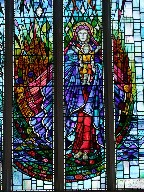| |
|
The Oulton Broad area of Lowestoft has an
idyllic name, but much of it consists of the 19th
century terraces which spread along the Lowestoft
ring road, and the 1960s infill estate between
here and Kirkley. Any sense
of being in a village is long gone - actually,
there never really was a village, and until the
19th century this place was in the parish of Corton Colville.
This area was built to house the
workers in Sir Morton Peto's new Lowestoft docks. St Mark is
slap on the ring road, which must simply be one
of the most awful roads in Suffolk. It carries
the A12 from London to Yarmouth through the
suburbs of Lowestoft, and at this point is a
single lane in each direction, squeezing through
the terraces. Here, it converges with other roads
for Mutford Bridge, one of only two crossings
over the Lothing between North and South
Lowestoft; the road on the north side is newer,
and wider, but here it was designed for 19th
century horse-drawn vehicles. No wonder that most
traffic prefers to plough on regardless through
central Lowestoft, although not enough to make
this a pleasant place. It isn't often I get off
my bike and push it, but here I did.
St Mark is sandwiched between the
river crossing and a narrow railway bridge over
the Lowestoft to Ipswich line. The church was
built by local architects Roberts, Green and
Richards in 1884, with none of the grandeur and
finesse which characterise that decade. It
consists of a simple nave and chacel, with a
little bellcote at the west end. The whole thing
is made out of Woolpit brick, Not always the best
material for a building in an industrial area,
The building has a clerestory of
lancets, and a red brick arcade of lancets below
it, as though designed to have aisles added at a
later date. This never happened, but a
transept-like organ chamber and vestry were built
on, and in 1990 the substantial parish rooms to
the north of the building were opened and
dedicated by the Bishop of Norwich. So this is
clearly a busy parish. I am afraid that the
original entry for St Mark on this website was
not terribly well-received by the parish, not
least because I grumbled about the locked doors.
I came back
here on Historic Churches Bike Ride day 2009,
fairly certain of being able to see inside. I had
to wait for a wedding to finish, but when I came
back the people on duty in the porch were very
welcoming. They were happy for me to see inside,
although they had to unlock the church for me to
do it, which tells you a lot. I stepped into the
rather curious interior. You can see straight
away that aisles were originally intended,
because the arcades were actually built. Still
filled in, with smaller windows in some of them,
they thoroughly dominate the interior, making the
building seem much narrower than it is, and
drawing the eye towards the east and the large,
open chancel. Here, there is a huge surprise, a
fabulous east window of about 1960 by Abbot &
Co, depicting the Blessed Virgin and Child. I
thought it was magnificent, although perhaps a
little surprised by the choice of subject for
what was obviously such a thorough-going
evangelical faith community.
| However, as I
turned to look around the rest of the
building I was thrown a little on my own
resources, despite just having read Sam
Mortlock's account of his visit here,
because the building has been thoroughly
reordered since his time, with most of
the nineteenth century furnishings
removed, and replaced with comfy purple
chairs and a blue carpet. Walking back westwards, I
was struck by how the clerestories, the
dimness of the roof and those sulking
blank arcades conspired together to
create the effect of a tall, grand and
yet rather anonymous building. The
reticulated tracery in the west-window
dominated the view, and reminded me for a
moment of the big churches built in
northern France to replace those
destroyed in the First World War.
Perhaps it was the
sheer modernity of the fixtures and
fittings. Maybe I pined perversely for
dusty tiled floors, pitch-pine benches
and a smell of gas. Regular
users of this site will know that I am a
fan of Victorian churches, but even in a
better setting this church would be
nothing but functional; and yet it has
survived, and thrives, when so many of
Lowestoft's 19th century churches have
not.
|
|
 |
|
|
|

